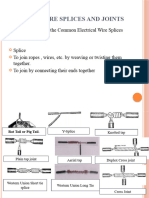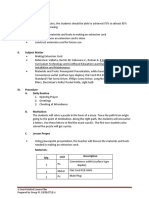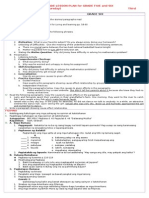Tle 9
Tle 9
Uploaded by
Lilian Laurel CariquitanCopyright:
Available Formats
Tle 9
Tle 9
Uploaded by
Lilian Laurel CariquitanOriginal Description:
Original Title
Copyright
Available Formats
Share this document
Did you find this document useful?
Is this content inappropriate?
Copyright:
Available Formats
Tle 9
Tle 9
Uploaded by
Lilian Laurel CariquitanCopyright:
Available Formats
TLE 9 ELECTRICAL INSTALLATION & MAINTENANCE NC II
ELECTRIC DISCHARGE LIGHTING SYSTEM
FLUORESCENT LAMP
Electric Discharge current/ electricity that does not flow in a conductor.
THEORIES / PRINCIPLE:
A fluorescent lamp is a form of electric discharge lighting source. It consist of a glass tube containing
mercury vapor at a low pressure and inert gases like argon and krypton. The interior is coated with
phosphor, which glows or fluoresces when exposed to ultra violet light. Coating the inner surface of the
glass tube with different phosphors make it possible to obtain light corresponding to the type of the
phosphor coating. There are several types of electric discharge lamps which are classified according to the
kind of electrode used.
1. Cold Cathode Lamp - requires high voltage in its operation. This lamp has electrode made of thin type
iron. It is not pre- heated and does not require a starter for starting. It is operated by a special high voltage
transformer.
Examples of Cold Cathode lamps: Neon lamps and Mercury lamps
2. Hot Cathode Lamp requires starter ( glow switch ) and is preheated during starting. It uses a ballast
to produce high voltage to start the lamp into operation and to limit the flow of current. This fluorescent
lamp which is commonly used for general lighting system is one of the hot cathode type.
A fluorescent lamp fixture consist of several parts which are listed and describe below:
1. Fluorescent tube is a circular or tubular tube containing mercury vapor and inert gas with phosphor
coating inside.
Types of fluorescent lamp : tubular & circular
Wattage Rating ( Tubular ):
8 watts lamp & 10 watts lamp --- use 10 watts ballast
18 watts lamp & 20 watts lamp ----use 20
watts ballast
36 watts lamp , 40 watts lamp & 38 watts lamp ----- use 40 watts ballast
2. Ballast is an induction coil which produces high voltage to start the lamp into operation. It also limits
the flow of current during the operation of the lamp. It also consumes power which is about 10% 20% of
the power consumed by the lamp itself.
Induce process of increasing voltage.
3. Starter - is a glow switch that opened and closed the circuit so as to produce high voltage or inductive
kick across the filament during the starting period. It has a bi metallic element that when it feels heat, it
will open.
Two Types of Fluorescent Starter
FS 20 for 20 W fluorescent lamp & FS 40 for 40 W fluorescent lamp
4. Lamp Holder & Starter Socket are points of connection of the fluorescent tube and the starter.
5. Frame is the metal housing of the whole fixture.
PRINCIPLE OF OPERATION
The first step in the ballast starting sequence of a fluorescent lamp is to preheat the cathodes. The
current heats the cathodes until they boil off clouds of electrons. Initially, the starter is at close position
to allow complete circuit for current to flow.
When the cathode had heated up, the starter opens. The magnetic field of the ballast collapses. This action
generated an inductive voltage kick which strikes an arc across the lamp, causing it to light.
Characteristics of Fluorescent Lighting
Advantages:
1. Highly efficient supplies four times as much light as incandescent lamp of the same wattage.
2. Available in types to supply variety of colors
3. Produce cooler illumination. It is possible to keep a hand on the tube during normal operation.
4. Produces distributed light which is less injurious to the eye.
5. Expected life is up to seven times more than incandescent lamps.
Disadvantages:
1. Initial cost is greater.
2. Starts with flickering light.
3. Operates at low power factor.
IDENTIFYING GOOD OR BAD FLUORESCENT STARTER
INDICATOR
CAUSES
REMARKS
No Light
Open circuit
Bad
Dim light / steady
Short circuit
Bad
Flickering light
Conditioned
Good
INDICATOR
No Light
Normal Light
Dimmed Light
IDENTIFYING GOOD OR BAD BALLAST
CAUSES
Open circuit
Short circuit
Conditioned
IDENTIFYING GOOD OR BAD FLUORESCENT TUBE
INDICATOR
CAUSES
No deflection
Open cathode
Full deflection
Short circuit
30 ohms 50 ohms
Conditioned
REMARKS
Bad
Bad
Good
REMARKS
Bad
Bad
Good
TROUBLESHOOTING CHART FOR FLUORESCENT LAMPS
SYMPTOMS
CAUSES
REMEDIES
1. Flashing On & OFF
- End of Life ( If old Lamp )
- Replace lamp
- Possible fault of lamp holder
- Replace lamp holders. If blinking
continues, investigate further
- Faulty starter
- Replace starter
- Low ballast rating
- Check ballast and replace
ballast if necessary
- Low circuit voltage
- Check voltage and correct if
- Loose contacts
possible
- See that lamps are securely
fitted and holders rigidly mounted
2. No Starting Effort or Slow
Starting
- End of life
- Defective starter
- Incorrect wiring
-
Low line voltage
Air leak in lamp
Low ballast rating
Open electrode circuit
Possible open circuit
- Replace lamp
- Replace starter
- Check wiring and make proper
connection
- Check voltage and correct if
possible
- Replace lamp
- Check ballast and replace
- Replace lamp
- Test lamp in other circuit
3. End of lamp remain lighted
- Faulty starter
- Incorrect wiring
- Low ballast rating
- Replace starter
- Make proper connections
- Replace ballast
4. Flicker, swirl, flutter
- New lamps may flicker when
first placed in service
- End of life if old lamps
- Defective starter
- High voltage
- Usually clears after short
operation
5. End blackening dense at one
end or
both
End of life
Defective starter
High or low voltage
Loose circuit
- Improper ballast
- Replace lamp
- Replace starter
- Check voltage and correct if
possible
- Replace lamp
- Replace starter
- Check voltage and correct if
possible
- See that lamps are securely
fitted and holders rigidly mounted
- Use approved ballast of correct
rating
6. Decrease light output
- Low circuit voltage
- Dust , dirt on lamps, fixtures,
walls
- Check voltage and correct if
possible
- Clean
7. Radio Interference
- radio too close to lamp
- Move radio 9 10 ft. from lamp
8. Noise from ballast
- Slight hum is inherent
- If objectionable, mount ballast in
soft rubber
- Replace ballast if too noisy
You might also like
- Summer Internship Project (Amul India)Document62 pagesSummer Internship Project (Amul India)Yajurv Atmapujya87% (45)
- EIM 7 - 8-Module 1Document24 pagesEIM 7 - 8-Module 1Donna Shane ReyesNo ratings yet
- Grade 9 Q2 TLE-EIM LASDocument56 pagesGrade 9 Q2 TLE-EIM LASSheila May Montanez100% (1)
- Fluorescent Lighting FixtureDocument17 pagesFluorescent Lighting FixtureelyNo ratings yet
- Eim Ncii Lmg9 p23-80Document58 pagesEim Ncii Lmg9 p23-80Jean Rose BalbontinNo ratings yet
- EIM Activity Sheet Q1, W9Document7 pagesEIM Activity Sheet Q1, W9Jessie OlantigueNo ratings yet
- Eim 7 - 8 Q4 Module 1Document24 pagesEim 7 - 8 Q4 Module 1Ailyn Guevarra100% (1)
- EIM 7 Module 3Document24 pagesEIM 7 Module 3John B. BataraNo ratings yet
- Department of Education Manila: Week 1-2 / 1 Grading PeriodDocument2 pagesDepartment of Education Manila: Week 1-2 / 1 Grading PeriodJhobhel Christopher Galivo100% (3)
- Incandescent Lamp Slide ShareDocument32 pagesIncandescent Lamp Slide ShareDaniel SampagaNo ratings yet
- Eim 10 Exit ExaminationDocument5 pagesEim 10 Exit ExaminationNoel Bua-ay100% (1)
- Quarter 1 Week 4: Electrical Installation and Maintenance (EIM) Grade 10Document21 pagesQuarter 1 Week 4: Electrical Installation and Maintenance (EIM) Grade 10Jhobhel Christopher Galivo50% (2)
- Bow Eim 9 Q2Document3 pagesBow Eim 9 Q2Jayson Deocareza Dela Torre100% (2)
- Circuit Using 3 Way Switch (S3W) Schematic Diagram Pictorial DrawingDocument17 pagesCircuit Using 3 Way Switch (S3W) Schematic Diagram Pictorial DrawingMa Cecelia BorjaNo ratings yet
- Electricity Grade10Document221 pagesElectricity Grade10Aldrin Santos100% (1)
- Electricity Module 1Document15 pagesElectricity Module 1Reinier Paclibar FederizoNo ratings yet
- Daily Lesson PlanDocument3 pagesDaily Lesson PlanKemArconadaNo ratings yet
- JHS Electrical 9 Module 1 PDFDocument15 pagesJHS Electrical 9 Module 1 PDFMark Xyriel BartolomeNo ratings yet
- Prepare Electrical Supplies, Materials An Tools: Created byDocument17 pagesPrepare Electrical Supplies, Materials An Tools: Created byRandy TurredaNo ratings yet
- DLP 22 2nd QDocument4 pagesDLP 22 2nd QKemArconadaNo ratings yet
- Grade9 - Rat Tail SpliceDocument6 pagesGrade9 - Rat Tail SpliceEu Nice100% (1)
- Electrical ToolsDocument5 pagesElectrical ToolsANTHONY JAY QUINTERONo ratings yet
- Lesson Plan in EIM8Document10 pagesLesson Plan in EIM8Aldren MahilumNo ratings yet
- Sptve: Electrical Installation and Maintenance (Eim) 9Document26 pagesSptve: Electrical Installation and Maintenance (Eim) 9Tade GaromaNo ratings yet
- EIM 9 Quarter Electrical ToolsDocument35 pagesEIM 9 Quarter Electrical ToolsJe Ann OlaytaNo ratings yet
- Industrial Arts Department: Self-Instructional Packets Electrical Installation and Maintenance 10Document9 pagesIndustrial Arts Department: Self-Instructional Packets Electrical Installation and Maintenance 10Aldrin Santos100% (1)
- Tle Eim Week 1Document7 pagesTle Eim Week 1Daniel Sampaga100% (1)
- TLE 9 EIM 9 Q3 M2Document14 pagesTLE 9 EIM 9 Q3 M2Katelyn BronzalNo ratings yet
- Technology and Livelihood Education: Electrical Installation and MaintenanceDocument18 pagesTechnology and Livelihood Education: Electrical Installation and MaintenanceJoshua Asoy100% (1)
- Electrical Hand Tools and Equipment's: Module in TLE 8Document4 pagesElectrical Hand Tools and Equipment's: Module in TLE 8Israel Marquez100% (2)
- DLP EIM Receive and Inspect Electrical Supplies and MaterialsDocument3 pagesDLP EIM Receive and Inspect Electrical Supplies and MaterialsJoel Magcamit Caoli100% (2)
- LE-week-6 and 7 Lesson 4 Eim Quarter 3Document7 pagesLE-week-6 and 7 Lesson 4 Eim Quarter 3Aurelio LagunaNo ratings yet
- TLEEIM Grade9 QTR3 Module1 Part1 Lighting Fixtures and Lamps Modular 1Document23 pagesTLEEIM Grade9 QTR3 Module1 Part1 Lighting Fixtures and Lamps Modular 1Lorde FloresNo ratings yet
- Part 3 Lesson 2 - Different Types of Form Used in Electrical WorksDocument21 pagesPart 3 Lesson 2 - Different Types of Form Used in Electrical WorksGladys Anne Espiritu100% (1)
- TLE 9 EIM 9 Q3 M2revDocument5 pagesTLE 9 EIM 9 Q3 M2revBenjamin FalletNo ratings yet
- EIM Activity Sheet Q1, W6Document6 pagesEIM Activity Sheet Q1, W6Jessie Olantigue100% (1)
- EIM NCII LMG9 p81-114 PDFDocument34 pagesEIM NCII LMG9 p81-114 PDFLleojVanceAguasClava75% (8)
- IPlan in TLE Grade 9 Electricity Jonrell LayosDocument4 pagesIPlan in TLE Grade 9 Electricity Jonrell Layosジェフリー リベラNo ratings yet
- Electrical Installation and Maintenance NC Ii Grade 9 Quarter IDocument7 pagesElectrical Installation and Maintenance NC Ii Grade 9 Quarter IJORDAN LANGUIDO100% (2)
- Lubricate Electric Tools in Line With Manufacturer's SpecificationDocument52 pagesLubricate Electric Tools in Line With Manufacturer's SpecificationKeempee ArconadaNo ratings yet
- TLEEIM - Grade9 - QTR4 - Module1 - Analyze Signs Symbols and DataDocument21 pagesTLEEIM - Grade9 - QTR4 - Module1 - Analyze Signs Symbols and DataLorde FloresNo ratings yet
- Grade 9 EIM BOWDocument2 pagesGrade 9 EIM BOWdickysrael.gatdula100% (1)
- Melc SummaryDocument8 pagesMelc SummaryPaulo Capunitan100% (1)
- Technical-Vocational Livelihood Industrial Arts: Electrical Installation and Maintenance Quarter 1 - Module 1.2Document28 pagesTechnical-Vocational Livelihood Industrial Arts: Electrical Installation and Maintenance Quarter 1 - Module 1.2Mark RagosNo ratings yet
- Ia - Electricity - Preparing Electric and Hydraulic ToolsDocument53 pagesIa - Electricity - Preparing Electric and Hydraulic ToolsPaul Pabilico Porras100% (1)
- Schools Division of Parañaque City TLE - Electrical Installation & Maintenance 9 Quarter 4 Week 3 & 4 Electrical ToolsDocument4 pagesSchools Division of Parañaque City TLE - Electrical Installation & Maintenance 9 Quarter 4 Week 3 & 4 Electrical ToolsWinsher PitogoNo ratings yet
- EIM Activity Sheet Q1, W2Document7 pagesEIM Activity Sheet Q1, W2Jessie OlantigueNo ratings yet
- Lesson Plan 7 Electrical Installation and Maintenance I. ObjectivesDocument7 pagesLesson Plan 7 Electrical Installation and Maintenance I. Objectivescecille mañacapNo ratings yet
- Common Wire Splices and JointsDocument15 pagesCommon Wire Splices and JointsNorman PolilinNo ratings yet
- Third Quarter EIM9 MR Judy BacligDocument33 pagesThird Quarter EIM9 MR Judy BacligMarwin Navarrete100% (1)
- TLEEIM Grade9 QTR3 Module1 Part2 Lighting-Fixtures-and-Lamps-modular-2Document20 pagesTLEEIM Grade9 QTR3 Module1 Part2 Lighting-Fixtures-and-Lamps-modular-2Lorde Flores100% (1)
- Quarter 1 Week 2 2: Electrical Installation and Maintenance Grade 12Document25 pagesQuarter 1 Week 2 2: Electrical Installation and Maintenance Grade 12Job F.Salamero Jr.No ratings yet
- TLE-EIM Grade9 Module Quarter1 Week3and4Document11 pagesTLE-EIM Grade9 Module Quarter1 Week3and4Renzo zorillaNo ratings yet
- Benthel Test Question in EimDocument3 pagesBenthel Test Question in EimMHar TrazonaNo ratings yet
- Common Wire Spilices and Joints - css9q3 - lp5Document18 pagesCommon Wire Spilices and Joints - css9q3 - lp5Michelle Jane Reyes100% (1)
- EIM G12 Module 7 Q1Document19 pagesEIM G12 Module 7 Q1KAGIG TVNo ratings yet
- I. Objectives: A Semi-Detailed Lesson Plan Prepared by Group Vi, Ii Bsed Tle-ADocument5 pagesI. Objectives: A Semi-Detailed Lesson Plan Prepared by Group Vi, Ii Bsed Tle-AVivian SalahidNo ratings yet
- EIMDocument3 pagesEIMRene Janog DenoreNo ratings yet
- Fluorescent LAMPSDocument23 pagesFluorescent LAMPSKevin NdetiNo ratings yet
- Fluorescent Lighting FixturesDocument23 pagesFluorescent Lighting FixturesJaville Bartina Jamorawon100% (1)
- ECNG Design Project - Year 1Document38 pagesECNG Design Project - Year 1kurmakkNo ratings yet
- Table of Specification: First Periodical Test in Mathematics I SY 2014 - 2015Document2 pagesTable of Specification: First Periodical Test in Mathematics I SY 2014 - 2015Lilian Laurel CariquitanNo ratings yet
- Deped Sec - Briones MessageDocument1 pageDeped Sec - Briones MessageLilian Laurel CariquitanNo ratings yet
- Book Numbers: Name of Pupils Book Names Grade 5 Math WikaDocument10 pagesBook Numbers: Name of Pupils Book Names Grade 5 Math WikaLilian Laurel CariquitanNo ratings yet
- Dr. Arden MonisitDocument2 pagesDr. Arden MonisitLilian Laurel CariquitanNo ratings yet
- Certification: District of Dalaguete I Amonsao Elementary SchoolDocument1 pageCertification: District of Dalaguete I Amonsao Elementary SchoolLilian Laurel CariquitanNo ratings yet
- Book Numbers: Name of Pupils Book Names Grade 5 Math WikaDocument6 pagesBook Numbers: Name of Pupils Book Names Grade 5 Math WikaLilian Laurel CariquitanNo ratings yet
- Magnetic Pick Up: You Will NeedDocument6 pagesMagnetic Pick Up: You Will NeedLilian Laurel CariquitanNo ratings yet
- Multigrade Lesson Plan For Grade Five and Six DATE:December 4, 2014 (Thursday) Third Grading Period Grade Five Grade SixDocument4 pagesMultigrade Lesson Plan For Grade Five and Six DATE:December 4, 2014 (Thursday) Third Grading Period Grade Five Grade SixLilian Laurel CariquitanNo ratings yet
- Multigrade Lesson Plan For Grade Five and Six DATE:December 2, 2014 (Tuesday) Third Grading Period Grade Five Grade SixDocument4 pagesMultigrade Lesson Plan For Grade Five and Six DATE:December 2, 2014 (Tuesday) Third Grading Period Grade Five Grade SixLilian Laurel CariquitanNo ratings yet
- Grade Five Grade SixDocument5 pagesGrade Five Grade SixLilian Laurel CariquitanNo ratings yet
- Tube MillDocument43 pagesTube MillHamed MostafaNo ratings yet
- CBSE Class 9 English Drama Villa For SaleDocument17 pagesCBSE Class 9 English Drama Villa For SaleDreamy YTNo ratings yet
- Silhouette 500 PDFDocument2 pagesSilhouette 500 PDFCarlos Padilla0% (1)
- English Test Life 1 Name: Class: : 0. You Cannot Have A Cigarette HereDocument2 pagesEnglish Test Life 1 Name: Class: : 0. You Cannot Have A Cigarette HereMaya TranNo ratings yet
- Interchange Formats For Spatial AudioDocument2 pagesInterchange Formats For Spatial AudioipiresNo ratings yet
- European Patent Specification B64C 27/32: Printed by Jouve, 75001 PARIS (FR)Document12 pagesEuropean Patent Specification B64C 27/32: Printed by Jouve, 75001 PARIS (FR)Amir BahramiNo ratings yet
- Activity 2 - Moving AveragesDocument4 pagesActivity 2 - Moving AveragesMei MCasNo ratings yet
- Arguments Manifestoes Day 1 and 2Document28 pagesArguments Manifestoes Day 1 and 2Lea Cabar100% (1)
- Let's Begin : Why We Procrastinate Even When It Feels Bad To Do ItDocument2 pagesLet's Begin : Why We Procrastinate Even When It Feels Bad To Do ItCelina TobarezNo ratings yet
- Make Peace - FileDocument21 pagesMake Peace - FileLarbi NadiaNo ratings yet
- UnderDoubleEagle TousignantDocument31 pagesUnderDoubleEagle TousignantLarry GehringNo ratings yet
- Operating Instructions and Maintenance Manual For LV AC Induction MotorsDocument22 pagesOperating Instructions and Maintenance Manual For LV AC Induction MotorsAlwyzz Happie RaamzzNo ratings yet
- Lecture 5 Equillibrium of ForcesDocument41 pagesLecture 5 Equillibrium of ForcesAwais Ahmed MirzaNo ratings yet
- A Shady Plot Is A Short Ghost Story by ElsieDocument18 pagesA Shady Plot Is A Short Ghost Story by ElsieNaampreet Singh0% (1)
- M54 Unit 1-IntroductionDocument17 pagesM54 Unit 1-IntroductionPhilip Yap100% (1)
- Tom Ford Research PaperDocument6 pagesTom Ford Research Paperh01xzacm100% (1)
- Soil Chemistry: CHM 001 Chemistry For EngineersDocument40 pagesSoil Chemistry: CHM 001 Chemistry For EngineersEjay CabangcalaNo ratings yet
- Gebräuchliche Arzneimittel in Der Praxis, 3. Auflage-Springer, Wien (2011) - PDFDocument585 pagesGebräuchliche Arzneimittel in Der Praxis, 3. Auflage-Springer, Wien (2011) - PDFesmiracelilova42No ratings yet
- Computer Education Franchise - Computer Institute Franchise - Computer Center FranchiseDocument24 pagesComputer Education Franchise - Computer Institute Franchise - Computer Center Franchisecomputer education franchiseNo ratings yet
- Cambio de Ubicaciones Sede CuscoDocument62 pagesCambio de Ubicaciones Sede CuscoClinton Maico MezaNo ratings yet
- Mada Walabu University English Language Improvement Center/Program (Elic/P) Training Module For Graduate Class StudentsDocument77 pagesMada Walabu University English Language Improvement Center/Program (Elic/P) Training Module For Graduate Class StudentsSamuel AdamuNo ratings yet
- API 510 2014 Mumbai PDFDocument2 pagesAPI 510 2014 Mumbai PDFBurapha Malutphanth33% (3)
- EMT101 Homework 3Document2 pagesEMT101 Homework 3WeeIngNo ratings yet
- Instruction Manual: Propane Insect FoggerDocument12 pagesInstruction Manual: Propane Insect Foggeranon_985994571No ratings yet
- Naskah PublikasiDocument13 pagesNaskah Publikasiashry09No ratings yet
- Research Paper False MemoryDocument8 pagesResearch Paper False Memoryaflbsybmc100% (1)
- Chemistry of The Elements (2nd Edition)Document14 pagesChemistry of The Elements (2nd Edition)mycomiccityNo ratings yet
- Special Purpose Coupons Holder AssembliesDocument3 pagesSpecial Purpose Coupons Holder AssembliesLekhamani YadavNo ratings yet
- Hard MomentumDocument10 pagesHard Momentumzeina.abdulal09No ratings yet



































































































